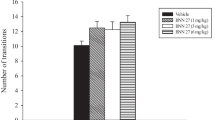The aim of the present work was to assess the effects of chronic administration of NAN-190, a 5-HT1A receptor antagonist (0.1 mg/kg, i.p.), and the 5-HT2A/2C receptor antagonist ketanserin (0.1 mg/kg, i.p.) for 14 days on anxiety and depression-like behavior in female rats during the ovarian cycle. Depression was modeled in rats using the Porsolt test. Levels of anxiety were evaluated using the elevated plus maze test. Chronic ketanserin was found to have antidepressant and anxiolytic effects in rats during estrous phases and proestrus. Administration of NAN-190, conversely, facilitated the development of a more profound state of depression in estrous phases and proestrus. Administration of this substance was followed by clear modulation of anxiety behavior depending on the phase of the estrous cycle: anxiolytic effects were seen when endogenous estrogen levels were high, while anxiogenic effects were seen at low estrogen levels. This is evidence for different levels of involvement of different serotonin receptor subtypes in the mechanisms of anxious-depressive behavior in conditions of a changing hormonal background during the estrous cycle. These data point to a close relationship between the ovarian hormonal and brain serotoninergic systems in the mechanisms of anxiety behavior and depression.
Similar content being viewed by others
References
V. N. Babichev, “Neuroendocrine effects of sex hormones,” Usp. Fiziol. Nauk., 36, No. 1, 54–67 (2005).
T. A. Voronina and S. B. Seredenin, “Methods for studies of the tranquillizing (anxiolytic) actions of pharmacological substances,” in: Guidelines for the Experimental (preclinical) Study of New Pharmacological Substances [in Russian], IIA Remedium, Moscow (2000).
Ya. D. Kirshenblat, Handbook in Endocrinology [in Russian], Vysshaya Shkola, Moscow (1969).
Z. Amin and C. N. Epperson, “Effect of estrogen-serotonin interactions on mood and cognition,” Cogn. Neurosci. Rev., 4, 43–58 (2005).
N. P. Barnes and T. Sharp, “A review of central 5-HT receptors and their function,” Neuropharmacol., 38, 1083–1152 (1999).
C. L. Bethea, N. Z. Lu, C. Gundlan, and J. M. Streicher, “Diverse actions of ovarian steroids in the serotonin neural system,” Front. Neuroendocrinol., 23, 41–100 (2002).
G. Diaz-Veliz, T. Alarcon, C. Espinoza, N. Dussaubat, and S. Mora, “Ketanserin and anxiety levels: influence of gender, estrous cycle, ovariectomy and ovarian hormones in female rats,” Pharmacol. Biochem. Behav., 58, 637–642 (1997).
U. Halbreich, “Anxiety disorders in women: a developmental and lifecycle perspective,” Depress. Anxiety, 17, 107–110 (2003).
G. P. Luscombe, K. F. Martin, L. J. Hutchins, J. Gosden, and D. J. Heal, “Mediation of the antidepressant-like effect of 8-OH-DPAT in mice by postsynaptic 5-HT1A receptors,” Brit. J. Pharmacol., 108, 669–677 (1993).
“Bipolar disorder: leads from the molecular and cellular mechanisms of action of mood stabilizers,” Brit. J. Psychiatry, 41, Supplement, 107–119 (2001).
B. S. McEwen, “Genome and hormones: gender differences in physiology. Invited review: estrogens effects on the brain: multiple sites and molecular mechanisms,” J. Appl. Physiol., 91, 2785–2801 (2001).
B. S. McEwen, “Estrogen actions throughout the brain,” Rec. Progr. Horm. Res., 57, 357–384 (2002).
J. P. Olie, E. Costa, J. Silva, and J. P. Macher, Neuroplasticity: a New Approach to the Pathophysiology of Depression, Science Press, London (2004).
R. D. G. Porsolt, G. Anton, N. Blavet, and M. Jalfre, “Behavioural despair in rats: a new model sensitive to antidepressant treatment,” Eur. J. Pharmacol., 47, 379–391 (1978).
Author information
Authors and Affiliations
Corresponding author
Additional information
Translated from Rossiiskii Fiziologicheskii Zhurnal imeni I. M. Sechenova, Vol. 96, No. 4, pp. 426–432, April, 2010.
Rights and permissions
About this article
Cite this article
Fedotova, Y.O. Effects of Ketanserin on Anxiety-Depression-Like Behavior in Female Rats during Key Phases of the Ovarian Cycle. Neurosci Behav Physi 41, 833–836 (2011). https://doi.org/10.1007/s11055-011-9494-6
Received:
Revised:
Published:
Issue Date:
DOI: https://doi.org/10.1007/s11055-011-9494-6



